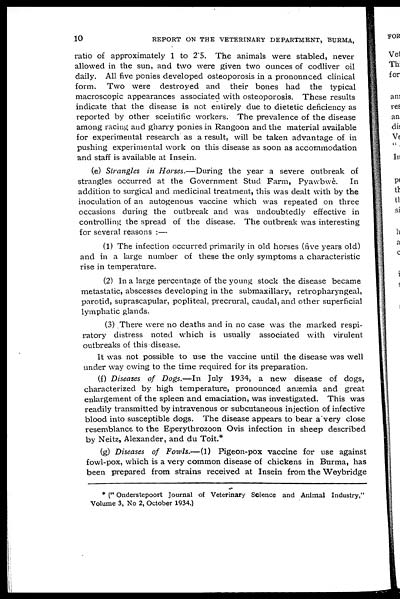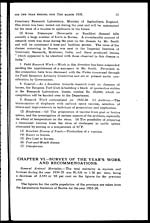Medicine - Veterinary > Civil Veterinary Departments > 1910-1941 - Annual report on the Civil Veterinary Department, Burma (including the Insein Veterinary School) > 1932-1941 > 1935
(184) Page 10
Download files
Individual page:
Thumbnail gallery: Grid view | List view

10 REPORT ON THE VETERINARY DEPARTMENT, BURMA,
ratio of approximately 1 to 2.5. The animals were stabled, never
allowed in the sun, and two were given two ounces of codliver oil
daily. All. five ponies developed osteoporosis in a pronounced clinical
form. Two were destroyed and their bones had the typical
macroscopic appearances associated with osteoporosis. These results
indicate that the disease is not entirely due to dietetic deficiency as
reported by other sceintific workers. The prevalence of the disease
among racing and gharry ponies in Rangoon and the material available
for experimental research as a result, will be taken advantage of in
pushing experimental work on this disease as soon as accommodation
and staff is available at Insein.
(e) Strangles in Horses.—During the year a severe outbreak of
strangles occurred at the Government Stud Farm, Pyawbwè. In
addition to surgical and medicinal treatment, this was dealt with by the
inoculation of an autogenous vaccine which was repeated on three
occasions during the outbreak and was undoubtedly effective in
controlling the spread of the disease. The outbreak was interesting
for several reasons :—
(1) The infection occurred primarily in old horses (five years old)
and in a large number of these the only symptoms a characteristic
rise in temperature.
(2) In a large percentage of the young stock the disease became
metastatic, abscesses developing in the submaxillary, retropharyngeal,
parotid, suprascapular, popliteal, precrural, caudal, and other superficial
lymphatic glands.
(3) There were no deaths and in no case was the marked respi-
ratory distress noted which is usually associated with virulent
outbreaks of this disease.
It was not possible to use the vaccine until the disease was well
under way owing to the time required for its preparation.
(f) Diseases of Dogs.—In July 1934, a new disease of dogs,
characterized by high temperature, pronounced anæmia and great
enlargement of. the spleen and emaciation, was investigated. This was
readily transmitted by intravenous or subcutaneous injection of infective
blood into susceptible dogs. The disease appears to bear a very close
resemblance to the Eperythrozoon Ovis infection in sheep described
by Neitz, Alexander, and du Toit.*
(g) Diseases of Fowls.—(1) Pigeon-pox vaccine for use against
fowl-pox, which is a very common disease of chickens in Burma, has
been prepared from strains received at Insein from the Weybridge
* (" Onderstepoort Journal of Veterinary Science and Animal Industry,"
Volume 3, No 2, October 1934.)
Set display mode to: Large image | Zoom image | Transcription
Images and transcriptions on this page, including medium image downloads, may be used under the Creative Commons Attribution 4.0 International Licence unless otherwise stated. ![]()
| Permanent URL | https://digital.nls.uk/75802957 |
|---|




